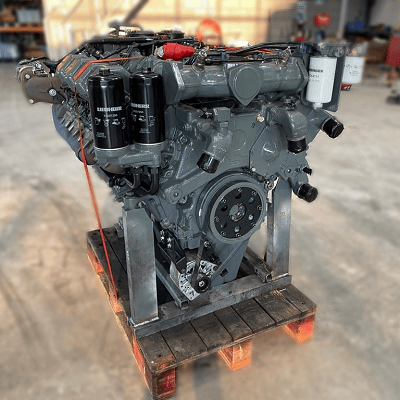When it comes to heavy machinery, reliability and power are paramount. Liebherr, a name synonymous with innovation and excellence in engineering, stands tall as a pioneer in the realm of heavy equipment and machinery. From towering cranes to robust excavators, Liebherr’s engineering prowess extends to the heart of these machines. We delve into the world of dyno testing a Liebherr engine, uncovering the meticulous process behind unleashing the raw power concealed within. Before we embark on the journey of dyno testing, it’s crucial to understand the foundation upon which Liebherr engines are built. With decades of engineering expertise and commitment to quality, Liebherr engines are crafted to withstand the most demanding environment and deliver unparalleled performance. Each component is meticulously designed and rigorously tested to ensure reliability, efficiency and longevity. 1 Preparation: The engine undergoes meticulous preparation before being mounted onto the dynamo meter. This includes ensuring all connections are secure, fluids are filled to the appropriate levels, and sensors are properly calibrated. 2 Mounting: The engine is carefully mounted onto the dynamometer, a specialized device designed to simulate real-world operating conditions. Precision is paramount during this step to ensure accurate results. 3 Initial checks: Once mounted, a series of initial checks are conducted to verify proper alignment, connection integrity, and functionality of all engine systems. 4 Warm-up: The engine is started and allowed to warm up to operating temperature. This ensures consistent results and minimizes the risk of damage during testing. 5 Baseline testing: With the engine warmed up , baseline tests are conducted to establish initial performance metrics. This includes measuring power output, torque, fuel consumption, and emissions at various RPM levels. 6 Load testing: The engine is subjected to progressively increasing loads to simulate different operating conditions, such as idle, partial load and full load. This allows engineers to assess performance across the entire operating range and identify any potential issues or optimization. 7 Data analysis: Throughout the testing process, data is continuously collected and analyzed in real-time. Advanced instrumentation and software are used to monitor performance metrics and identify trends or anomalies. 8 Optimazation: Based on the data analysis, adjustments may be made to optimize engine performance. This could involve fine-tuning fuel injection timing, adjusting air-fuel ratios, or optimize turbocharger boost pressure. 9 Validation: Once testing is complete, the results are meticulously reviewed and validated against predetermined criteria and specifications. Any deviations or anomalies are thoroughly investigated to ensure accuracy and reliability. 10 Reporting: Finally, a comprehensive report is generated detailing the results of the dyno testing, including performance metrics, observations, and any recommendations for further optimization or refinement. Dyno testing a Liebherr engine is more than just a routine procedure – it’s a testament to the unwavering commitment to excellence that defines Liebherr’s engineering philosophy. By subjecting their engines to rigorous testing and analysis, Liebherr ensures that each engine delivers the uncompromising performance, reliability, and efficiency that customers expect. In conclusion, dyno testing a Liebherr engine is not just about measuring power output. It’s about unlocking the true potential of these remarkable engines and ensuring they exceed expectations in the most challenging environments imaginable. Pigment Printing Thickener,Thickener For Pigment Printing,Paint Thickener Guangzhou Quanxu Technology Co Ltd , https://www.silicamattingagent.com
The process of a dyno test on a Liebherr engine

The foundation of excellence
The process
The outcome of dyno testing
A pigment Thickening Agent, also known as a rheology modifier or thixotropic agent, is a type of chemical substance that helps in controlling the viscosity and flow properties of paints, inks, and other pigment-based products. These agents can increase the viscosity of the mixture without changing its other properties such as color, opacity, or drying time.
The primary function of a pigment thickening agent is to prevent the sedimentation of pigments over time, ensuring a more consistent product quality. This is particularly important for products where the pigment concentration is high. Here are some common types of pigment thickening agents:
1. Polymeric Thickeners: These are large molecules made from polymers that form networks within the paint, providing stability and viscosity.
2. Organic Thickeners: These include substances like bentonite, carboxymethyl cellulose (CMC), and polyvinyl alcohol (PVA). They are often used because they are compatible with a wide range of pigments and solvents.
3. Inorganic Thickeners: Examples include clays like bentonite and kaolin. They work by absorbing water and swelling, which increases viscosity.
4. Hydroxyethylcellulose (HEC): A type of cellulose derivative that can be used to thicken aqueous systems. It's biodegradable and food-grade.
5. Cellulose Ether Derivatives: Such as hydroxypropyl methylcellulose (HPMC) and methyl cellulose (MC), which are used in both waterborne and solvent-based systems.
6. Polyacrylates: Synthetic polymers that can be used to adjust viscosity and stabilize dispersions.
7. Silicones: These can be used to modify the surface properties of pigments, affecting their dispersibility and the final viscosity of the mixture.
Choosing the right thickening agent depends on several factors including the type of pigment, the solvent system, the desired viscosity, and the environmental impact considerations. It's crucial to test different agents under similar conditions to ensure compatibility and optimal performance.
window.authenticationPopup = {"autocomplete":"off","customerRegisterUrl":"https:\/\/www.cranepartssupply.com\/en\/customer\/account\/create\/","customerForgotPasswordUrl":"https:\/\/www.cranepartssupply.com\/en\/customer\/account\/forgotpassword\/","baseUrl":"https:\/\/www.cranepartssupply.com\/en\/","customerLoginUrl":"https:\/\/www.cranepartssupply.com\/en\/customer\/ajax\/login\/"}
{
"#authenticationPopup": {
"Magento_Ui/js/core/app": {"components":{"authenticationPopup":{"component":"Magento_Customer\/js\/view\/authentication-popup","children":{"messages":{"component":"Magento_Ui\/js\/view\/messages","displayArea":"messages"},"captcha":{"component":"Magento_Captcha\/js\/view\/checkout\/loginCaptcha","displayArea":"additional-login-form-fields","formId":"user_login","configSource":"checkout"}}}}} },
"*": {
"Magento_Ui/js/block-loader": "https\u003A\u002F\u002Fwww.cranepartssupply.com\u002Fstatic\u002Fversion1728988868\u002Ffrontend\u002FComaxx\u002FPartsSupply\u002Fen_US\u002Fimages\u002Floader\u002D1.gif"
}
}
{
"*": {
"Magento_Customer/js/section-config": {
"sections": {"stores\/store\/switch":["*"],"stores\/store\/switchrequest":["*"],"directory\/currency\/switch":["*"],"*":["messages"],"customer\/account\/logout":["*","recently_viewed_product","recently_compared_product","persistent"],"customer\/account\/loginpost":["*"],"customer\/account\/createpost":["*"],"customer\/account\/editpost":["*"],"customer\/ajax\/login":["checkout-data","cart","captcha"],"catalog\/product_compare\/add":["compare-products"],"catalog\/product_compare\/remove":["compare-products"],"catalog\/product_compare\/clear":["compare-products"],"sales\/guest\/reorder":["cart"],"sales\/order\/reorder":["cart"],"checkout\/cart\/add":["cart","directory-data"],"checkout\/cart\/delete":["cart"],"checkout\/cart\/updatepost":["cart"],"checkout\/cart\/updateitemoptions":["cart"],"checkout\/cart\/couponpost":["cart"],"checkout\/cart\/estimatepost":["cart"],"checkout\/cart\/estimateupdatepost":["cart"],"checkout\/onepage\/saveorder":["cart","checkout-data","last-ordered-items"],"checkout\/sidebar\/removeitem":["cart"],"checkout\/sidebar\/updateitemqty":["cart"],"rest\/*\/v1\/carts\/*\/payment-information":["cart","last-ordered-items","captcha","instant-purchase"],"rest\/*\/v1\/guest-carts\/*\/payment-information":["cart","captcha"],"rest\/*\/v1\/guest-carts\/*\/selected-payment-method":["cart","checkout-data"],"rest\/*\/v1\/carts\/*\/selected-payment-method":["cart","checkout-data","instant-purchase"],"customer\/address\/*":["instant-purchase"],"customer\/account\/*":["instant-purchase"],"vault\/cards\/deleteaction":["instant-purchase"],"persistent\/index\/unsetcookie":["persistent"],"review\/product\/post":["review"],"wishlist\/index\/add":["wishlist"],"wishlist\/index\/remove":["wishlist"],"wishlist\/index\/updateitemoptions":["wishlist"],"wishlist\/index\/update":["wishlist"],"wishlist\/index\/cart":["wishlist","cart"],"wishlist\/index\/fromcart":["wishlist","cart"],"wishlist\/index\/allcart":["wishlist","cart"],"wishlist\/shared\/allcart":["wishlist","cart"],"wishlist\/shared\/cart":["cart"],"catalog\/customproduct\/add":["cart"],"braintree\/paypal\/placeorder":["cart","checkout-data"],"braintree\/googlepay\/placeorder":["cart","checkout-data"]},
"clientSideSections": ["checkout-data","cart-data"],
"baseUrls": ["https:\/\/www.cranepartssupply.com\/en\/"],
"sectionNames": ["messages","customer","compare-products","last-ordered-items","cart","directory-data","captcha","instant-purchase","loggedAsCustomer","persistent","review","wishlist","recently_viewed_product","recently_compared_product","product_data_storage"] }
}
}
{
"*": {
"Magento_Customer/js/customer-data": {
"sectionLoadUrl": "https\u003A\u002F\u002Fwww.cranepartssupply.com\u002Fen\u002Fcustomer\u002Fsection\u002Fload\u002F",
"expirableSectionLifetime": 61,
"expirableSectionNames": ["cart","persistent"],
"cookieLifeTime": "3600",
"updateSessionUrl": "https\u003A\u002F\u002Fwww.cranepartssupply.com\u002Fen\u002Fcustomer\u002Faccount\u002FupdateSession\u002F"
}
}
}
{
"*": {
"Magento_Customer/js/invalidation-processor": {
"invalidationRules": {
"website-rule": {
"Magento_Customer/js/invalidation-rules/website-rule": {
"scopeConfig": {
"websiteId": "1"
}
}
}
}
}
}
}
{
"body": {
"pageCache": {"url":"https:\/\/www.cranepartssupply.com\/en\/page_cache\/block\/render\/page_id\/268\/","handles":["default","cms_page_view","cms_page_view_id_the-process-of-a-dyno-test-on-a-liebherr-engine"],"originalRequest":{"route":"cms","controller":"page","action":"view","uri":"\/en\/the-process-of-a-dyno-test-on-a-liebherr-engine"},"versionCookieName":"private_content_version"} }
}